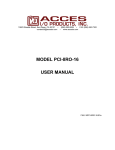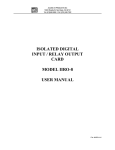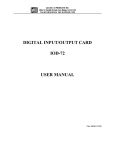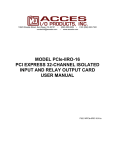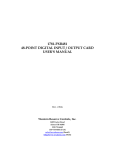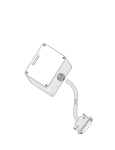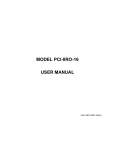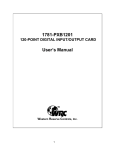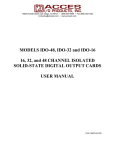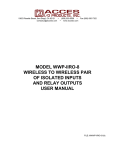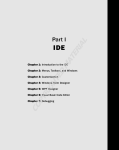Download MODEL PCI-IIRO-8 USER MANUAL
Transcript
10623 Roselle Street, San Diego, CA 92121 • (858) 550-9559 • FAX (858) 550-7322 [email protected] • www.accesio.com MODEL PCI-IIRO-8 USER MANUAL FILE: PCI-IIRO-8.B1f Notice The information in this document is provided for reference only. ACCES does not assume any liability arising out of the application or use of the information or products described herein. This document may contain or reference information and products protected by copyrights or patents and does not convey any license under the patent rights of ACCES, nor the rights of others. IBM PC, PC/XT, and PC/AT are registered trademarks of the International Business Machines Corporation. Printed in USA. Copyright 1995, 2005 by ACCES I/O Products Inc, 10623 Roselle Street, San Diego, CA 92121. All rights reserved. WARNING!! ALWAYS CONNECT AND DISCONNECT YOUR FIELD CABLING WITH THE COMPUTER POWER OFF. ALWAYS TURN COMPUTER POWER OFF BEFORE INSTALLING A CARD. CONNECTING AND DISCONNECTING CABLES, OR INSTALLING CARDS INTO A SYSTEM WITH THE COMPUTER OR FIELD POWER ON MAY CAUSE DAMAGE TO THE I/O CARD AND WILL VOID ALL WARRANTIES, IMPLIED OR EXPRESSED. 1 Manual PCI-IIRO-8 Warranty Prior to shipment, ACCES equipment is thoroughly inspected and tested to applicable specifications. However, should equipment failure occur, ACCES assures its customers that prompt service and support will be available. All equipment originally manufactured by ACCES which is found to be defective will be repaired or replaced subject to the following considerations. Terms and Conditions If a unit is suspected of failure, contact ACCES' Customer Service department. Be prepared to give the unit model number, serial number, and a description of the failure symptom(s). We may suggest some simple tests to confirm the failure. We will assign a Return Material Authorization (RMA) number which must appear on the outer label of the return package. All units/components should be properly packed for handling and returned with freight prepaid to the ACCES designated Service Center, and will be returned to the customer's/user's site freight prepaid and invoiced. Coverage First Three Years: Returned unit/part will be repaired and/or replaced at ACCES option with no charge for labor or parts not excluded by warranty. Warranty commences with equipment shipment. Following Years: Throughout your equipment's lifetime, ACCES stands ready to provide on-site or in-plant service at reasonable rates similar to those of other manufacturers in the industry. Equipment Not Manufactured by ACCES Equipment provided but not manufactured by ACCES is warranted and will be repaired according to the terms and conditions of the respective equipment manufacturer's warranty. General Under this Warranty, liability of ACCES is limited to replacing, repairing or issuing credit (at ACCES discretion) for any products which are proved to be defective during the warranty period. In no case is ACCES liable for consequential or special damage arriving from use or misuse of our product. The customer is responsible for all charges caused by modifications or additions to ACCES equipment not approved in writing by ACCES or, if in ACCES opinion the equipment has been subjected to abnormal use. "Abnormal use" for purposes of this warranty is defined as any use to which the equipment is exposed other than that use specified or intended as evidenced by purchase or sales representation. Other than the above, no other warranty, expressed or implied, shall apply to any and all such equipment furnished or sold by ACCES. 2 Manual PCI-IIRO-8 Table of Contents Chapter 1: Introduction................................................................................................. 4 Specification .............................................................................................................. 5 Figure 1-1: Block Diagram ...................................................................................... 6 Chapter 2: Installation................................................................................................... 7 Chapter 3: Option Selection ......................................................................................... 9 Interrupts.................................................................................................................... 9 Figure 3-1: Option Selection Map............................................................................ 9 Chapter 4: Address Selection .................................................................................... 10 Chapter 5: Programming ............................................................................................ 11 Chapter 6: Software .................................................................................................... 13 Chapter 7: Connector Pin Assignments.................................................................... 14 Table 7-1: Connector Pin Assignments ................................................................. 14 3 Manual PCI-IIRO-8 Chapter 1: Introduction This is a half-size card that provides isolated digital input and output interface for PCI-Bus computers. The card has eight optically-isolated digital inputs for AC or DC control signals and eight electromechanical relay outputs. This card occupies four consecutive 8-bit registers in I/O space. Inputs The isolated inputs can be driven by either AC or DC signals and are not polarity sensitive. Input signals are rectified by a diode bridge and applied to the input of an opto-isolator. A 470Ω resistor in series provides current limiting. Standard 12/24 AC control transformer outputs can be accepted as well as DC voltages. The input voltage range is 5 to 24 volts (rms). External resistors connected in series may be used to extend the input voltage range. Each input circuit contains a switchable slow/fast filter that has a 10 millisecond time constant. (Without filtering, the response is 20 uSec.) The filter must be selected for AC inputs in order to eliminate response to zero crossings. The filter is also valuable for use with slow DC input signals in a noisy environment. The filter may be switched out for DC inputs in order to obtain faster response. Filters are individually selected by switch S2; IP0 is controlled by F0, IP1 by F1, IP2 by F2, etc. The filters are switched into the circuit when the switch is moved to the ON position. The filters may also be controlled globally under software control. All filters may be turned on by a read at base address +3. Filters that have been activated by software may be disabled by a write to base address +3. Interrupts When enabled by a software read to base address +2, the card asserts an interrupt whenever any of the inputs change state. Once an interrupt has been generated and serviced, it must be cleared. A software write to base address +1 will clear an interrupt. This interrupt capability may be disabled by a software write to base address +2. Outputs The electromechanical relay outputs are comprised of five Form C SPDT outputs and three Form A SPST (normally open) type. The relays are all de-energized at power-on. Data to the relays is latched by a write to the base address. On/off status of the relays can be read back by a read at the base address. 4 Manual PCI-IIRO-8 Specification Digital Inputs • Type: Non-polarized, optically isolated (not TTL compatible) • Voltage Range: 5 to 24V DC or AC (50 to 1000 Hz) • Isolation: 500V channel-to-ground or channel-to channel • Input Resistance: 470 ohms in series with two diodes and an LED • Response Time: 10 mSec w/filter, 20 μSec w/o filter Relay Outputs • Contact Rating: 2A carry current, single button, silver • Max switching current: 1A • Max switching Voltage: 60VDC @ 30W, 120VAC, 60VA • Contact Arrangement: Channels 0-4 are SPDT Form C and channels 5-7 are SPST Form A • Contact Resistance: Initial 100 milliohms maximum • Contact Life: mech'l: 5 million operations minimum • Contact Life: elect'l: 0.5 million operations minimum at full load • Operating Time: 2 milliseconds maximum • Release Time: 1 milliseconds maximum General • Interrupts: When enabled by software, interrupts are generated when digital inputs change state Environmental • Ambient Temperature: Operating: Storage: 0°C to +50°C -20°C to +70°C • Humidity: 0 to 90% (non-condensing) • Weight: Approx. 8 oz • Size: 6.15" long (156 mm) • Power Required: +5VDC @ 0.675A (all relays ON) Max Switching Power AC: 60 VA DC: 30 W 5 Manual PCI-IIRO-8 Figure 1-1: Block Diagram 6 Manual PCI-IIRO-8 Chapter 2: Installation A printed Quick-Start Guide (QSG) is packed with the card for your convenience. If you’ve already performed the steps from the QSG, you may find this chapter to be redundant and may skip forward to begin developing your application. The software provided with this card is on CD and must be installed onto your hard disk prior to use. To do this, perform the following steps as appropriate for your operating system. Configure Card Options via Jumper Selection Before installing the card into your computer, carefully read Chapter 3: Option Selection of this manual, then configure the card according to your requirements. Our Windows based setup program can be used in conjunction with Chapter 3 to assist in configuring jumpers on the card, as well as provide additional descriptions for usage of the various card options. CD Software Installation The following instructions assume the CD-ROM drive is drive “D”. Please substitute the appropriate drive letter for your system as necessary. DOS 1. 2. 3. 4. Place the CD into your CD-ROM drive. Type B- to change the active drive to the CD-ROM drive. Type GLQR?JJ- to run the install program. Follow the on-screen prompts to install the software for this board. WINDOWS 1. Place the CD into your CD-ROM drive. 2. The system should automatically run the install program. If the install program does not run promptly, click START | RUN and type BGLQR?JJ, click OK or press -. 3. Follow the on-screen prompts to install the software for this board. LINUX 1. Please refer to linux.htm on the CD-ROM for information on installing under linux. Caution! * ESD A single static discharge can damage your card and cause premature failure! Please follow all reasonable precautions to prevent a static discharge such as grounding yourself by touching any grounded surface prior to touching the card. 7 Manual PCI-IIRO-8 Hardware Installation 1. 2. 3. 4. 5. 6. 7. 8. 9. 10. Make sure to set switches and jumpers from either the Option Selection section of this manual or from the suggestions of SETUP.EXE. Do not install card into the computer until the software has been fully installed. Turn OFF computer power AND unplug AC power from the system. Remove the computer cover. Carefully install the card in an available 5V or 3.3V PCI expansion slot (you may need to remove a backplate first). Inspect for proper fit of the card and tighten screws. Make sure that the card mounting bracket is properly screwed into place and that there is a positive chassis ground. Install an I/O cable onto the card’s bracket mounted connector. Replace the computer cover and turn ON the computer which should auto-detect the card (depending on the operating system) and automatically finish installing the drivers. Run PCIfind.exe to complete installing the card into the registry (for Windows only) and to determine the assigned resources. Run one of the provided sample programs that was copied to the newly created card directory (from the CD) to test and validate your installation. The base address assigned by BIOS or the operating system can change each time new hardware is installed into or removed from the computer. Please recheck PCIFind or Device Manager if the hardware configuration is changed. Software you write can automatically determine the base address of the card using a variety of methods depending on the operating system. In DOS, the PCI\SOURCE directory shows the BIOS calls used to determine the address and IRQ assigned to installed PCI devices. In Windows, the Windows sample programs demonstrate querying the registry entries (created by PCIFind and NTIOPCI.SYS during boot-up) to determine this same information. 8 Manual PCI-IIRO-8 Chapter 3: Option Selection Filter Response Switch DIP switch S2 is used to select input filtering on a channel-by-channel basis. When S2-1 is ON, additional filtering is introduced for input bit 0, S2-2 for bit 1, etc. Switch Section Bit Filtered S2-1 IP0 -2 IP1 -3 IP2 -4 IP3 -5 IP4 -6 IP5 -7 IP6 -8 IP7 This additional filtering provides a slower response as described previously and must be used when AC inputs are applied. Note also, as previously described, that the filters can be globally activated (or deactivated) under software control at base address +3. Interrupts An interrupt is asserted by the card when an input data bit changes state if enabled by software as previously described. F7 F0 Figure 3-1: Option Selection Map 9 Manual PCI-IIRO-8 Chapter 4: Address Selection The card occupies four consecutive registers in I/O space.The PCI architecture is inherently plug-andplay in nature. This means that the BIOS or Operating System determines the resources assigned to PCI cards rather than you selecting those resources with switches or jumpers. As a result, you cannot set or change the card's base address. You can only determine what the system has assigned. To determine the base address that has been assigned, run the PCIFind.EXE utility program. This utility will display a list of all of the cards detected on the PCI bus, the addresses assigned to each function on each of the cards, and the respective IRQs and DMAs (if any) allotted. Alternatively, some operating systems can be queried to determine which resources were assigned. In these operating systems, you can use either PCIFind or the Device Manager utility from the System Properties Applet of the control panel. The card is installed in the Data Acquisition class of the Device Manager list. Selecting the card, clicking Properties, and then selecting the Resources Tab will display a list of the resources allocated to the card. The PCI bus supports 64K of address space, so your card's addresses may be located anywhere in the 0000 to FFFF hex range. PCIFind uses the Vendor ID and the Device ID to search for your card, then reads the base address and IRQ assigned. If you want to determine the base address and IRQ assigned, use the following information: The Vendor ID code is 494F (ASCII for "I/O") The device ID code is 0F00 10 Manual PCI-IIRO-8 Chapter 5: Programming The base or starting address is assigned by the computer system during installation and will fall on a four bit boundary. This card’s read and write functions are as follows: I/O Address Read Write Base +0 Read Relay Output Write Relay Output Base +1 Read Isolated Inputs Clear Interrupt Base +2 Enable IRQ Disable IRQ Base +3 Activate Filter Deactivate Filter Digital Inputs Digital input states are read as a single byte from the port at Base Address +1. Each of the eight bits within the byte corresponds to a particular digital input. A "1" signifies that the input is energized and a "0" signifies that the input is de-energized. Bit Position D7 D6 D5 D4 D3 D2 D1 D0 Digital Input IP7 IP6 IP5 IP4 IP3 IP2 IP1 IP0 The card's response to inputs is rated at 20 uSec or faster. Sometimes it is necessary to slow down that response to accommodate AC inputs or in noisy environments. The 10 mSec filter can be enabled for all inputs in software by reading at base address +3 or disabled by writing at base address +3. The card supports interrupts on change of state of digital inputs. Thus, it is not necessary to continuously poll inputs (by reading at base address +1) to detect any state change. To enable this interrupt capability, read at base address +2. To disable interrupts, write at base address +2. To clear an IRQ, write at base address +1. Relay Outputs At power-up, all relays are de-energized. The current state of the relays can be determined at any time by a read operation at the base address. The relay outputs are controlled by writing to the base address. Data are written to all eight relays as a single byte. Each bit within the byte controls a specific relay. A "1" energizes the corresponding relay and a "0" turns it off. Bit Position Relay D7 D6 D5 D4 D3 OP7 OP6 OP5 OP4 OP3 D2 D1 D0 OP2 OP1 OP0 For example, if bit D5 is turned on by writing hex 20 to the base address the relay that controls OP5 is energized (closing the associated normally-open contacts). All other relays would be de-energized and their normally-closed contacts would be closed. 11 Manual PCI-IIRO-8 Programming Examples No API driver software is provided with the card because programming is very simple and can be accomplished most efficiently using direct I/O instructions in DOS. Use the standard ACCES32 API driver for windows. The following examples are in C but are readily translated into other languages: Example: Turn on OP0 and OP7 Base=0xF300; outportb(Base, 0x81); //Base I/O address Example: Read back the state of the relays X=inportb(Base); printf("%02x"); //relay register data to X% //display results Example: Read the digital inputs Y=inportb(Base+1); //digital input register to Y% 12 Manual PCI-IIRO-8 Chapter 6: Software Utility software provided with the card is the base address locator, an illustrated setup program, and a sample program. The sample program sequentially turns on each relay until all are on and then sequentially turns them off. After each relay is turned on, the relay states are read back, the opto-isolated inputs are read, and the data are displayed. The programs are as follows: SETUP.EXE: Setup Program DOS\ CSAMPLES: BSAMPLES: PSAMPLES: These three directories contain DOS samples in Borland C, Microsoft QuickBASIC 4.5, and Turbo Pascal 7.0 DELPHI: CBUILDER: VBASIC: VISUALC These four directories contain samples in Borland Delphi 4.0, Borland C++Builder 3.0, Microsoft VisualBASIC 5.0, and Microsoft VisualC++ 5.0: These samples will run in Windows95, Windows98, or WindowsNT 4.0. Before running these Win32 samples, make sure you have properly installed the ACCES32 driver (installed as part of the TOOLS package.) WIN32\ 13 Manual PCI-IIRO-8 Chapter 7: Connector Pin Assignments Analog and digital I/O signals are connected to the card via a 37-pin D type connector that extends through the back of the computer case. The mating connector is an AMP 747304-1 or equivalent. The wiring may be directly from the signal sources or may be on ribbon cable from screw terminal accessory boards. Pin Name Function 1 IP7 Digital Input Bit 7 2 IP6 Digital Input Bit 6 3 IP5 Digital Input Bit 5 4 IP4 Digital Input Bit 4 5 IP3 Digital Input Bit 3 6 IP2 Digital Input Bit 2 7 IP1 Digital Input Bit 1 8 IP0 Digital Input Bit 0 9 OP7(C) Bit 7 Relay Common 10 OP6(C) Bit 6 Relay Common 11 OP5(C) Bit 5 Relay Common 12 OP4(NC) Bit 4 Relay, Normally-Closed Contact 13 OP4(NO) Bit 4 Relay, Normally-Open Contact 14 OP3(C) Bit 3 Relay Common 15 OP2(NC) Bit 2 Relay, Normally-Closed Contact 16 OP2(NO) Bit 2 Relay, Normally-Open Contact 17 OP1(C) Bit 1 Relay Common 18 OP0(NC) Bit 0 Relay, Normally-Closed Contact 19 OP0(NO) Bit 0 Relay, Normally-Open Contact 20 IP7 Digital Input Bit 7 21 IP6 Digital Input Bit 6 22 IP5 Digital Input Bit 5 23 IP4 Digital Input Bit 4 24 IP3 Digital Input Bit 3 25 IP2 Digital Input Bit 2 26 IP1 Digital Input Bit 1 27 IP0 Digital Input Bit 0 28 OP7(NO) Bit 7 Relay, Normally-Open Contact 29 OP6(NO) Bit 6 Relay, Normally-Open Contact 30 OP5(NO) Bit 5 Relay, Normally-Open Contact 31 OP4(C) Bit 4 Relay Common 32 OP3(NC) Bit 3 Relay, Normally-Closed Contact 33 OP3(NO) Bit 3 Relay, Normally-Open Contact 34 OP2(C) Bit 2 Relay, Common 35 OP1(NC) Bit 1 Relay, Normally-Closed Contact 36 OP1(NO) Bit 1 Relay, Normally-Open Contact 37 OP0(C) Bit 0 Relay, Common Table 7-1: Connector Pin Assignments 14 Manual PCI-IIRO-8 Customer Comments If you experience any problems with this manual or just want to give us some feedback, please email us at: [email protected]. Please detail any errors you find and include your mailing address so that we can send you any manual updates. 10623 Roselle Street, San Diego CA 92121 Tel. (619)550-9559 FAX (619)550-7322 www.accesio.com 15 Manual PCI-IIRO-8


















